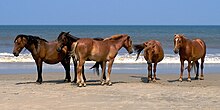 Feral Banker horses in Corolla, North Carolina | |
| Country of origin | United States |
|---|---|
| Traits | |
| Distinguishing features | Small, compact conformation |
| Breed standards | |
The Banker horse is a breed[1] of semi-feral or feral horse (Equus ferus caballus) living on barrier islands in North Carolina's Outer Banks. It is small, hardy, and has a docile temperament, and is genetically related to the Carolina Marsh Tacky of South Carolina and Florida Cracker Horse breeds through their shared Colonial Spanish horse and Iberian horse descent. The current population of wild Banker horses is estimated to be about 400.
Bankers are allowed to remain on the islands due to their historical significance even though they can trample plants and ground-nesting animals and are not considered to be indigenous. They survive by grazing on marsh grasses, which supply them with water as well as food, supplemented by temporary freshwater pools.
To prevent overpopulation and inbreeding, and to protect their habitat from being overgrazed, the horses are managed by the National Park Service, the state of North Carolina, and several private organizations. The horses are monitored for diseases, such as equine infectious anemia, an outbreak of which was discovered and subsequently eliminated on Shackleford in 1996. They are safeguarded from traffic on North Carolina Highway 12. Island populations are limited by adoptions and by birth control. Bankers taken from the wild and trained have been used for trail riding, driving, and occasionally for mounted patrols.
In June 2010, the Banker horse ("Colonial Spanish Mustang") was made the official state horse of North Carolina.[2]
- ^ "Conservation Priority List". The Livestock Conservancy. Retrieved 23 June 2023.
- ^ Hampton, Jeff (3 June 2010). "Wild horses set to become North Carolina state horse". The Virginian-Pilot. Retrieved 23 June 2023.